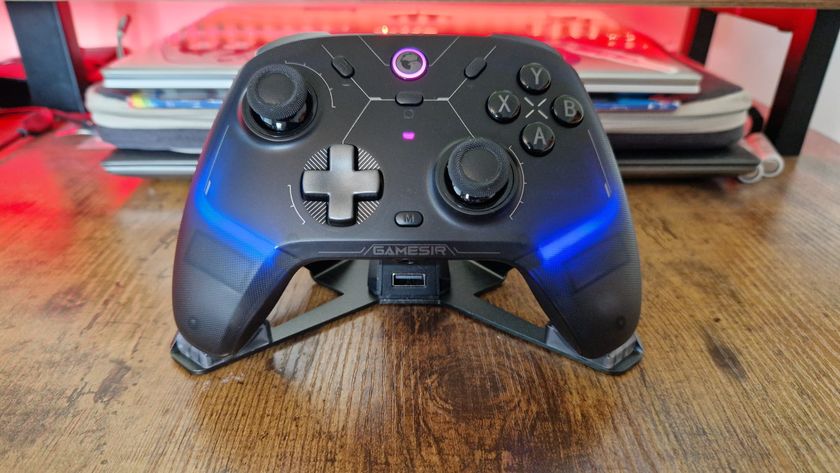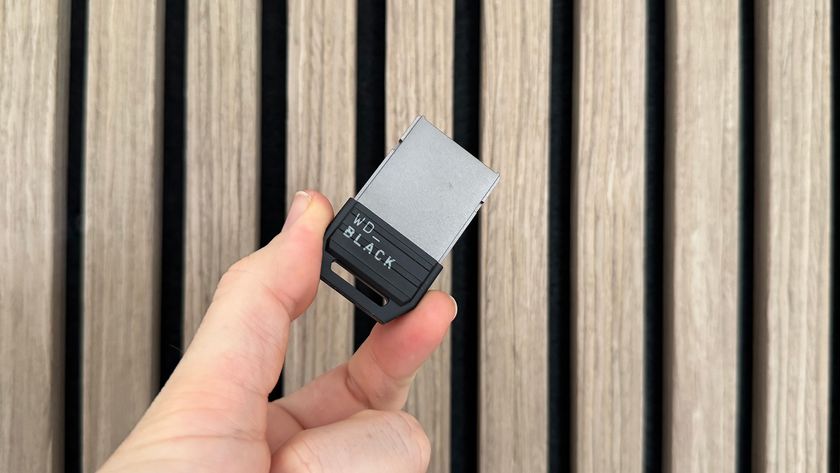12DOVE Verdict
The Razer Kraken V4 is the iconic headset all grown up, but it’s got tough competition in its $179.99 price tag - even from within its own brand. An excellent build quality, full-bodied audio profile (with a few tweaks), and versatile system of connections make for the full package - but there is better value slightly further down the price scale.
Pros
- +
Slimmer design than previous versions
- +
Excellent detailing
- +
Handy retractable microphone
- +
Easy wireless compatibility
- +
Wide range of EQ customization options
- +
RGB, if you’re into that
Cons
- -
Headband can cause pressure on the crown
- -
Relatively short battery life for the price
- -
Lower quality microphone than BlackShark V2
- -
Bass ranges are weak straight out the box
Why you can trust 12DOVE
The Razer Kraken range is iconic. Forget the brand’s lineup, these chunkier PC-focused cups are immediately recognizable against the entire gaming headset market, and with good reason. Between the budget Kraken X line taking over affordable setups and the haptic-buzzing flagships leading the way in immersion, this is a range with some serious pedigree. The latest Razer Kraken V4 shakes things up a little with its streamlined design, but it’s still the core Kraken experience we all know and love.
With updated internals and that RGB blazing as bright as ever, Razer’s $179.99 / £179.99 device wants to be the best gaming headset for mid-range PC players. This is a competitive price point, though, with SteelSeries, Turtle Beach, HyperX, and Logitech all pitching at the same lower-mid rate. The Razer Kraken V3’s biggest competition, though, comes from within the brand’s own roster - the BlackShark V2 Pro. With just $20 more on its price tag (and not even that when recurring sales are factored in), a better set of specs under the hood, and the same PC-focused offering, the Kraken V4 might not be doing enough to step out from the BlackShark’s shadow this time around.
| Price | $179.99 / £179.99 |
| Connection | 2.4GHz / Bluetooth 5.3 / Wired (USB-A) |
| Drivers | Razer TriForce Titanium 40mm |
| Frequency response | 20Hz - 28kHz |
| Microphone | HyperClear Super Wideband |
| ANC | No |
| Controls | Power, mic mute, volume, chat mix, Bluetooth switch, profile switch |
| Battery | Up to 50 hours |
| Weight | 350g |
| Compatibility | PC, PlayStation, Nintendo Switch, mobile |
Design
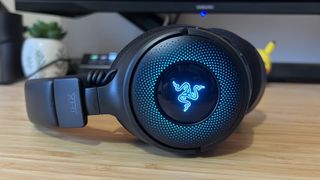
I remember the Krakens of yore, and they were chunky. The Razer Kraken V3 Hypersense was a monster of a headset, with huge, thick cups on each side of its industrial headband. The V4 almost feels lithe compared to these older releases, with a far more streamlined look and feel. Those iconic circular cups have been stretched out for more of an oval shape, which makes for a far more comfortable experience overall - the cushions hug around the natural contours of the ear rather than pushing against the tops. I never felt any ear-pinching during longer sessions as a result.
It’s not just the shape of those cups that’s been tweaked, the silhouette is ever so slightly slimmer as well. It sits closer to the head during wear, its form factor shaved down so as to not just out from the ears quite so far.
The padding itself is a nicely sturdy memory foam, covered with a mesh fabric that proves more durable and breathable compared to the leatherette you’ll find on previous models and the Razer Kraken V4 Pro. While traditionally considered the cheaper option, I much prefer this material. It’s softer, less irritating over extensive use, and avoids that sticky plasticky feeling when temperatures start to climb. There’s still plenty of sound isolation, though if you’re trying to block out louder noises a leatherette alternative might be better suited. Interestingly, the BlackShark line flips this script, using a softer mesh fabric on its V2 Pro model and a more isolating leatherette on the cheaper Hyperspeed.

Despite its $179.99 / £179.99 MSRP, this is an all-plastic device. Razer has kept things simple in construction, opting against heavier (but sturdier) aluminum materials to try and keep that weight as low as possible. I can see why - at 350g this is heavier than both the Razer BlackShark V2 Pro (320g) and Razer BlackShark V2 Hyperspeed (280g). It’s got a little more heft than average, but it’s still tip-toeing along the right side of the comfort line. There’s a good amount of cushioning running along the top headband, but it can push a little into the crown with the sheer weight of those cups. As it is, I can ignore the pressure for around three hours before needing a break. Denser, heavier materials would have easily made this too uncomfortable to use for sessions over an hour.

Plus, the Razer Kraken V4 still feels as durable as I would expect from a more premium build. That plastic never creaks or rattles, even after a few months of daily use, hinges are smooth and hold their position well, and the headband has a good degree of flex to it. It’s not quite as moldable as the SteelSeries Arctis Nova 5 Wireless, but it’s easy to see why with the thicker design. Each cup swivels beautifully to better adapt to your head shape, with an eight-level adjustable headband serving larger heads as well.
The cable running between the strut and main drivers is also nicely coiled to ensure it accommodates this stretch without too much tension. That’s a good amount of ergonomic support, with stretch and swivel allowing for a range of different head shapes and sizes, and a lighter clamp force keeping everything in position without feeling too overbearing.
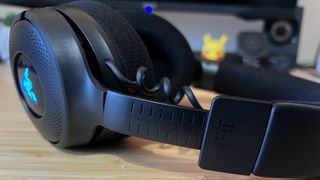
The microphone is neatly hidden inside the left cup, ready to be extended from its nook whenever required. This is a fantastic design, but Razer hasn’t quite pulled it off as well as SteelSeries. Every implementation of the Arctis Nova’s retractable mic is smooth and slick, whereas this version takes a little too much jimmying to pull out and push back in. The cable seems to feel squished inside, though I did notice this version is less sticky than the Kraken V4 Pro.
I’ve left the Razer Kraken V4’s most distinguishing design feature for last because, in the words of Ms Twain, that don’t impress me much. The RGB on the outside of each cup is flashy, and its LEDs are bright enough (if not quite as vivid as the lights on a Razer keyboard). But I don’t see it when I’m wearing it, a Twitch audience won’t see it unless you turn your head to the side, and it drains battery life completely. It’s an unnecessary extra that might appeal to RGB-heads, but is far from a must-see and adds to the price unnecessarily. Yeah, I know, I must be fun at parties.
Features
The Razer Kraken V4 is compatible with PlayStation, PC, Nintendo Switch, and mobile devices thanks to a considerable connection portfolio. While its Bluetooth and 2.4GHz dongle will keep you covered on consoles and handhelds, though, it really does find its home in the PC space. That’s immediately signaled by the USB-A wired connection (via an included USB-C to USB-A braided cable) but cemented in the THX Spatial support and reliance on Synapse features for full value.
You’ll have access to EQ, microphone, and RGB settings via this Windows software, with further profiles for gaming, music, and movies easily accessible via the headset itself. These profiles are a little janky, for want of a better word. I found all to be lacking in the lower end, which meant I generally rolled with my own preset for most games and music scenarios, lifting that bassline a little for movies.
The software itself is easily navigable enough, with menus, settings, and quick access features sitting where one would naturally expect them to be - even that can’t be taken for granted looking at alternative options. While Razer has been quick to state that the new Synapse 4 program is less CPU-intensive, though, that didn’t exactly prove true in my testing. Running the program direct on a Razer Blade 14 is still pretty demanding. I’ve had to stop it running in the background altogether during day-to-day tasks, to keep everything zippy. The actual experience of using Synapse is improved, though, with faster responses where actions were sluggish at best, and crashing at worst in older iterations.
Under the hood, the Razer Kraken V4 packs a set of 40mm Triforce Titanium drivers and the brand’s Hyperclear Super Wideband microphone. That’s a smaller driver set compared to the Razer BlackShark range, and this restriction makes itself known in the bass response. That microphone had me excited at the start of testing - its implementation on the BlackShark V2 Pro propelled the headset to stardom, offering super crisp vocals with excellent range, detailing, and a deeply textured tone.
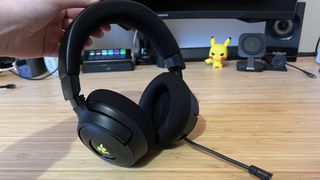
On paper, the Kraken V4 should offer the same response, but here the microphone doesn’t feel quite so substantial. It’s still a solid pickup, but there’s less richness and energy to the voice. There are perhaps some material changes under the hood here, or a disparity in pickup placement or size, because despite boasting the same name this isn’t quite the same experience.
Controls line both cups, with mic mute, volume, and power on the left and a Bluetooth smart switch and profile-switch / chat-mix button on the right. Everything is placed within easy reach and with a nicely textured surface on th power button it’s easy to quickly hit mic mute or head straight to the other cup for a profile change. The volume dial is a little too easy to hit, though. It’s incredibly loose and positioned just so that even my hood would sometimes roll it all the way up or down. Similarly, the power button doesn’t feel as tense as it should - I can hear it hitting against my hood or shoulder when moving my head to the side, rattling in its casing.
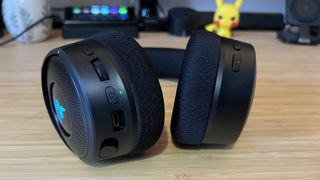
Battery life is rated for up to 50 hours without RGB switched on, and 30 hours with those lights blaring. Starting from a full charge, I made it through four and a half days of use before needing to plug in, using the headset for between five and seven hours per day. That’s still much lower than the BlackShark V2 Pro’s 70 hours and slightly lower than the SteelSeries Arctis Nova 7’s 38 hours.
Performance
Whereas the BlackShark is focused on speed, the Kraken wants to be the most immersive headset in the room. Straight out of the box there’s a solid balance across ranges, and an impressive soundstage with plenty of space for details. However, I did need to drive up the bassline to suit my own personal preference, as it came across a little weaker on my first few runs. Once I’d tinkered with those Synapse levers, I was able to achieve a nicely rich sound quality with crisp textures and an enjoyable, bouncy audio profile.
Directional audio isn’t quite as pinpoint-precise as that of the BlackShark. I was still able to locate enemies in Apex Legends, marking the sounds of footsteps and gunshots quite easily on my own mental map. However, the extent of that detail didn’t quite pull through to more dense settings like Spider-Man: Miles Morales. Walking through the Time to Rally scene, louder sounds were treated to far more detail whereas smaller directional cues seemed to be lost in the mix a little easier. Where these cues were of a lower mid-range frequency, the BlackShark V2 Pro picked them out with a little more spark.
This lack of low-range emphasis was most noticeable in Doom Eternal. While there was some excellent texture in the mid-range, I missed the boom of an explosion or the grunt of a big soundtrack moment. Bass boost certainly helped things along here, and switching over to PC I found THX Spatial Audio gave the whole battle a lot more body. Wiring in rather than relying on a 2.4GHz dongle helped further, allowing for more auditory information that gave me a much more textured soundstage. Demon screeches balanced beautifully with more powerful weapon sounds, and the soundtrack finally had the space it needed.
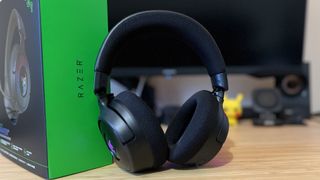
The lack of natural power in the lower range does mean that the Kraken V4 is able to deal with a clustered environment particularly well, especially if competing effects fall within the same ranges. The Kraken was able to accurately separate overbearing machine sounds from those of the wider environment, balancing the odd piece of dialogue and soundtrack swell impressively. That’s not something I can say about a lot of headsets, which tend to struggle with this game’s cacophonous setting.
It’s in slower, more ambient moments that the Kraken V4 impressed the most, though. Without needing to power too many low-range rumbles and balance mid-range effects, the soundstage and more delicate tonal qualities of these drivers were allowed to shine through. The claustrophobia of The Last of Us Part 2’s The Descent mission was translated particularly well even without THX on PS5. Smaller environmental noises were given ample space to ring through with clarity and terrifying ambience.
Should you buy the Razer Kraken V4?
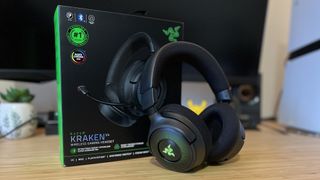
I’ll start with the good here. The Razer Kraken V4 features a fantastic build quality that proves you don’t need heavy, high-end materials to make a luxurious gaming headset. It feels more durable in the hand than the BlackShark V2 Hyperspeed ($129.99 / £129.99) while offering a set of cool, comfortable mesh earcups that I personally prefer to the BlackShark V2 Pro ($199.99 / £199.99). There’s plenty of clarity and detail in this audio naturally, and with a few tweaks to the lower ranges, it’s easy to curate a well-textured and full-bodied audio system that’s both energetic and powerful.
Now we’re onto the bad, and this is where that $179.99 / £179.99 MSRP gets the Kraken into trouble. While its design is better than the BlackShark range, its audio, microphone, and battery life all fall short - of even the cheaper Hyperspeed model. Its PC-focus also means console players should be turning to the SteelSeries Arctis Nova 5 (also $129.99) for more balancing options across PS5 and Xbox instead.
It’s a solid piece of kit, and doesn’t necessarily do anything wrong (if you don’t mind tweaking EQ settings a little). It just doesn’t do enough to satisfy the Razer tax. If the Kraken V4 had launched at $149.99 / £149.99 - just $30 less - things might be a little different. As it stands, there’s not a lot here to justify the extra cash when cheaper options are not only available, but sometimes performing better. If you’re looking for a well-rounded PC headset that concentrates more on immersive atmosphere and less on the speed of your directional audio (and you want to spend on Razer’s THX and Chroma feature) I would still recommend it. If you prioritize value for money and don’t want to tinker with EQ too often, there are cheaper options out there.
| Comfort | ★★★★☆ |
| Audio | ★★★☆☆ |
| Battery | ★★☆☆☆ |
| Microphone | ★★★★☆ |
| Versatility | ★★★☆☆ |
| Build quality | ★★★★☆ |
How I tested the Razer Kraken V4
I used the Razer Kraken V4 for all daily play, music, and streaming sessions across a span of two months, with two weeks of use alongside the Alienware Pro Wireless and Asus ROG Delta 2. Direct, specific testing was completed across Horizon Forbidden West, Spider-Man Miles Morales, Apex Legends, Doom Eternal, and The Last of Us Part 2, while also comparing results against the Razer Kraken V4 Pro, SteelSeries Arctis Nova 5 Wireless, Razer BlackShark V2 Pro, and Razer BlackShark V2 Hyperspeed. For more information on how we test gaming headsets, check out the full 12DOVE Hardware Policy.
We’re also rounding up all the best PS5 headsets on the market, as well as the best Xbox Series X headsets available. Or, for something more portable, check out the best gaming earbuds available now.

Managing Editor of Hardware at 12DOVE, I originally landed in hardware at our sister site TechRadar before moving over to GamesRadar. In between, I've written for Tom’s Guide, Wireframe, The Indie Game Website and That Video Game Blog, covering everything from the PS5 launch to the Apple Pencil. Now, i'm focused on Nintendo Switch, gaming laptops (and the keyboards, headsets and mice that come with them), PS5, and trying to find the perfect projector.

A Minecraft Movie Review: "Jack Black's irrepressible star turn helps elevate this video game adaptation"

Nintendo admits "there were times when we wished the Switch system's processor was faster" so that "developers could make any kind of game they wanted"
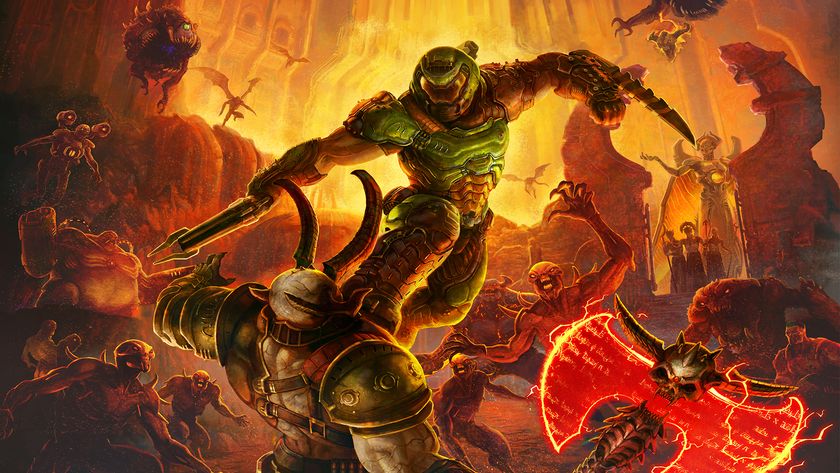
Switch 2 plays Switch 1 games through something "in between a software emulator and hardware compatibility," so don't expect the same backward compatibility we got on 3DS and Wii U

